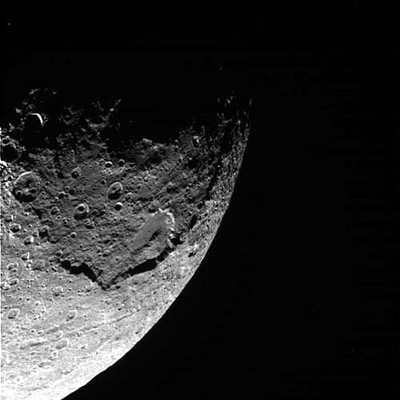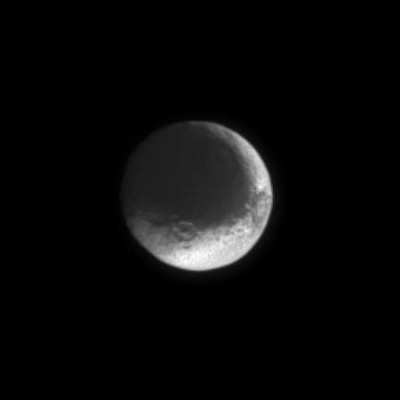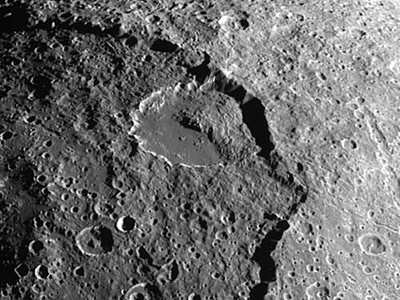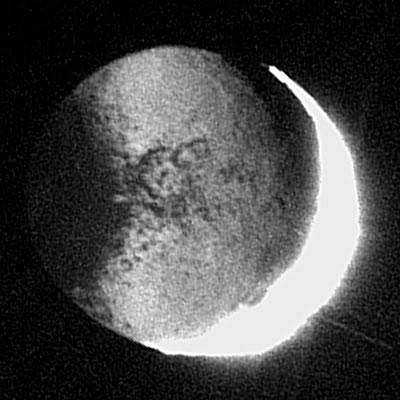Mon, Jan 10, 2005
Or Are You Just Happy We're In Orbit?
Images returned by NASA's Cassini spacecraft cameras during a
New Year's Eve flyby of Saturn’s moon Iapetus
(eye-APP-eh-tuss) show startling surface features that are fueling
heated scientific discussions about their origin.

One of these features is a long narrow ridge that lies almost
exactly on the equator of Iapetus, bisects its entire dark
hemisphere and reaches 20 kilometers high (12 miles). It extends
over 1,300 kilometers (808 miles) from side to side, along its
midsection. No other moon in the solar system has such a striking
geological feature. In places, the ridge is comprised of mountains.
In height, they rival Olympus Mons on Mars, approximately three
times the height of Mt. Everest, which is surprising for such a
small body as Iapetus. Mars is nearly five times the size of
Iapetus.

Iapetus is a two-toned moon. The leading hemisphere is as dark
as a freshly-tarred street, and the white, trailing hemisphere
resembles freshly-fallen snow.
The flyby images, which revealed a region of Iapetus never
before seen, show feathery-looking black streaks at the boundary
between dark and bright hemispheres that indicate dark material has
fallen onto Iapetus. Opinions differ as to whether this dark
material originated from within or outside Iapetus. The images also
show craters near this boundary with bright walls facing towards
the pole and dark walls facing towards the equator.

Cassini's next close encounter with Iapetus will occur in
September 2007. The resolution of images from that flyby should be
100 times better than the ones currently being analyzed. The hope
is that the increased detail may shed light on Iapetus’
amazing features and the question of whether it has been
volcanically active in the past.

With a diameter of about 1,400 kilometers (890 miles), Iapetus
is Saturn's third largest moon. It was discovered by Jean-Dominique
Cassini in 1672. It was Cassini, for whom the Cassini-Huygens
mission is named, who correctly deduced that one side of Iapetus
was dark, while the other was white.
More News
He Attempted To Restart The Engine Three Times. On The Third Restart Attempt, He Noticed That Flames Were Coming Out From The Right Wing Near The Fuel Cap Analysis: The pilot repor>[...]
Make Sure You NEVER Miss A New Story From Aero-News Network Do you ever feel like you never see posts from a certain person or page on Facebook or Instagram? Here’s how you c>[...]
From 2009 (YouTube Edition): Leading Air Show Performers Give Their Best Advice for Newcomers On December 6th through December 9th, the Paris Las Vegas Hotel hosted over 1,500 air >[...]
Aero Linx: NASA ASRS ASRS captures confidential reports, analyzes the resulting aviation safety data, and disseminates vital information to the aviation community. The ASRS is an i>[...]
“For our inaugural Pylon Racing Seminar in Roswell, we were thrilled to certify 60 pilots across our six closed-course pylon race classes. Not only did this year’s PRS >[...]
 NTSB Final Report: Rutan Long-EZ
NTSB Final Report: Rutan Long-EZ ANN FAQ: Turn On Post Notifications
ANN FAQ: Turn On Post Notifications Classic Aero-TV: ICAS Perspectives - Advice for New Air Show Performers
Classic Aero-TV: ICAS Perspectives - Advice for New Air Show Performers ANN's Daily Aero-Linx (06.28.25)
ANN's Daily Aero-Linx (06.28.25) Aero-News: Quote of the Day (06.28.25)
Aero-News: Quote of the Day (06.28.25)






